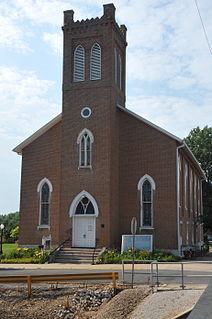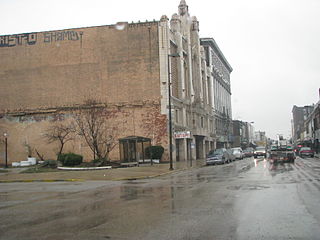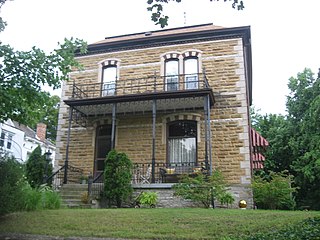
The George H. Miller House is a historic house located at 405 W. Market St. in Bloomington, Illinois. Prominent local architect George H. Miller built the house in 1890 for himself and his family. Miller designed many new buildings in downtown Bloomington after a 1900 fire destroyed much of the area; he also served as Superintendent of U.S. Buildings and designed many federal buildings in the Midwest. Miller's house is an eclectic variation on the Queen Anne design. The house features a hexagonal tower on its southeast corner and a conical dormer projecting from the front of the multi-component roof. The front entrance is arched and flanked by columns; small recessed porches are located above the entrance and on the east side of the house. The house has several stained glass windows, including a window with Miller's name at the front entrance and a large circular window on the west side.

The First Presbyterian Church is a museum and former Presbyterian church located at 301 W. Main St. in Vandalia, Illinois. The church was built in 1868 on the site of the first Protestant church in Illinois. The first church at the site, the House of Divine Worship, was a non-denominational church built in 1823 by the Illinois State Legislature; at the time, Vandalia was the state capital, and the governor's house was located next to the church. The Presbyterian church, built after the state capital moved to Springfield, was designed in the Gothic Revival style. The red brick church has a 60-foot (18 m) tall bell tower. The church has twelve Gothic pointed arch windows; each window has an oval stained glass pattern depicting a religious scene. Vandalia's Presbyterian congregation left the building for a new church in the 1960s, and the building is now used as the Fayette County Museum.

The Ida B. Wells-Barnett House was the residence of civil rights advocate Ida B. Wells (1862–1931) and her husband Ferdinand Lee Barnett from 1919 to 1930. It is located at 3624 S. Dr. Martin Luther King Jr. Drive in the Douglas community area of Chicago, Illinois. It was designated a Chicago Landmark on October 2, 1995. It was listed on the National Register of Historic Places and as a National Historic Landmark on May 30, 1974.

The Lake–Peterson House, also known as Jenny's, is a Victorian Gothic Revival home in Rockford, Illinois, United States. The house was built in 1873, probably by prominent Rockford citizen John Lake - its first owner, but its architect is unknown. The house is a significant example of Gothic Revival architecture and is considered one of the finest such homes in the U.S. state of Illinois. The Lake–Peterson House is owned and maintained by Swedish American Hospital in Rockford and stands adjacent to the main hospital complex along Business US 20. The building and its carriage house were added to the U.S. National Register of Historic Places in 1980.

The City Building is a Registered Historic Place in St. Charles, Illinois. It was the first structure in the city built specifically for government use, and has served variously as town hall, police station, fire house, circuit court, and public works monitoring station.

The Duke Ellington House is a historic residence at 935 St. Nicholas Avenue, in Manhattan, New York City. Apartment 4A in this apartment house was the home of Duke Ellington (1899-1974), the noted African American composer and jazz pianist, from 1939 through 1961. It was listed on the National Register of Historic Places as a National Historic Landmark in 1976.

St. Bartholomew's Episcopal Church is a historic church building located on Vermont Route 118 in Montgomery, Vermont in the United States. Its congregation was formed in 1821 as Union Episcopal Church. Church construction began in 1833 and was completed in 1835, when it was consecrated by the Rt. Rev. John Henry Hopkins, first bishop of the Episcopal Diocese of Vermont. In 1897 its name was changed to St. Bartholomew's Episcopal Church.

The Frank J. Baker House is a 4,800-square-foot Prairie School style house located at 507 Lake Avenue in Wilmette, Illinois. The house, which was designed by Frank Lloyd Wright, was built in 1909, and features five bedrooms, three and a half bathrooms, and three fireplaces. At this point in his career, Wright was experimenting with two-story construction and the T-shaped floor plan. This building was part of a series of T-shaped floor planned buildings designed by Wright, similar in design to Wright's Isabel Roberts House. This home also perfectly embodies Wright's use of the Prairie Style through the use of strong horizontal orientation, a low hanging roof, and deeply expressed overhangs. The house's two-story living room features a brick fireplace, a sloped ceiling, and leaded glass windows along the north wall; it is one of the few remaining two-story interiors with the T-shaped floor plan designed by Wright.

The Robert C. McEwen United States Custom House, also known as U.S. Customshouse, is a historic customshouse building located at Ogdensburg in St. Lawrence County, New York. It was built in 1809-1810 as a store and warehouse. It is a two-story, utilitarian, gable roofed, stone bearing wall structure approximately 60 feet wide and 120 feet long. The Federal government purchased it in 1936 and converted it for use as a customshouse. It is the oldest within the building inventory of the General Services Administration.

The Renwick Building is located in downtown Davenport, Iowa, United States. It has been listed on the National Register of Historic Places since 1983, and on the Davenport Register of Historic Properties since 2000. In 2020 it was included as a contributing property in the Davenport Downtown Commercial Historic District. It is known locally for the large painted sign on the north side of the building depicting the Bix 7 Road Race.

St. John the Baptist Catholic Church is a historic Roman Catholic church in Beloit, Kansas, United States. The church is listed on the National Register of Historic Places.

St. James Episcopal Church is an Episcopal church located at the northeast corner of MacArthur and Broadway in Lewistown, Illinois. The church serves the Lewistown Episcopal parish, which formed in 1860, six years after Episcopal services began in the city. S. Corning Judd, the senior warden of the parish, obtained plans for the church building from architect Edward Tuckerman Potter in 1862, and construction began on the church in 1863. Work on the church was finished in 1865, and church services began in the same year. The church took its name from St. James Cathedral in Chicago, since the bishop of that church granted Lewistown its parish. The red brick church's Gothic design features diagonal buttresses, arched windows and an arched door, decorative brickwork forming a pattern of X's on the west side, and a small bell tower.

St. Mark's Episcopal Church, also known as St. Marks P.E. Church, is a historic church located at 210 University Ave. in Tonopah, Nevada, United States. The church was built from 1906 to 1907 by stonemason E.E. Burdick. Burdick's work on the church has been called "some of the finest craftsmanship to be found in Tonopah". Architect G.B. Lyons designed the church in the Gothic Revival style; his design features Gothic arches at the windows and front entrance and gables topped with crosses on the roof and the entrance.

The Morgan County Courthouse, located at 300 W. State St. in Jacksonville, is the county courthouse of Morgan County, Illinois. The courthouse, the third built in Morgan County, was constructed from 1868 to 1869. Chicago architect Gurdon P. Randall designed the courthouse in a combination of the Italianate and Second Empire styles. The design is considered unusual among county courthouses, as counties generally preferred more traditional designs. Randall's design features an arched loggia surrounding the building's southern entrance, asymmetrical towers at the southern corners with mansard roofs and bracketed cornices, arched dormers within the towers' mansards, and an assortment of round-head and bulls-eye windows. One of the towers houses a 4,000 pounds (1,800 kg) bell, which was intended to be part of a clock that was never installed. A 9-foot (2.7 m) statue of Lady Justice, carved from a single block of pine, originally topped the front entrance; however, after losing its arms around 1872, the statue disappeared in the early 1900s and was never recovered.

The Majestic Theatre is a historic movie theater located at 240–246 Collinsville Ave. in East St. Louis, Illinois. Built in 1928, the theater replaced a 1907 theater which had burned down. The Spanish Gothic theater was designed by the Boller Brothers, who were nationally prominent theater architects. Multicolored tiles decorate the building's front facade, forming patterned mosaics. The front facade also features piers with decorative peaks and tall arched windows. The theater attracted numerous celebrities to its grand opening, and it represented several firsts among East St. Louis cinemas; it was the first in the city with a modern air conditioning system and the first in Southern Illinois to show talkies. The theater closed in the 1960s.

The Alexander Briggs House is a historic house located at 210 Jackson St. in Charleston, Illinois. Prominent local stonemason Alexander Briggs built the stone house in 1894; it is the only stone house remaining in Coles County. The house's design incorporates features of the Italianate and Renaissance Revival styles; the combination is unusual, as the Renaissance Revival style was rarely used in small houses. Briggs built the house with multicolored sandstone and used marble and granite to form decorative belt courses and quoins, giving the house its Renaissance Revival appearance. The house's Italianate elements include its tall, narrow arched windows and its gently sloping roof.

The Edward Kirk Warren House and Garage is a historic house located at 2829-2831 Sheridan Place in Evanston, Illinois. The house was built in 1910-12 for Edward Kirk Warren, an industrialist who developed the featherbone corset. Warren also served as president of the International Sunday School Association and provided financial support to evangelist Dwight L. Moody. Architect William Carbys Zimmerman, the Illinois State Architect at the time, designed the Tudor Revival house. The house was built from dressed ashlar, an uncommon building material for Tudor Revival houses; it is one of only two ashlar Tudor Revival houses in Evanston. The house's roof has a steep main gable with a parapet along with several smaller gables and dormers with a similar design. The entrance porch is supported by columns and covered by an overhang with bracketed eaves. An octagonal tower with ornamental griffins and a crenellated battlement rises to the left of the entrance. Other decorative features used in the exterior include stained glass, arched windows, and various patterns inlaid in the stone.
The DeFries House, Barn and Carpenter Shop are a collection of historic buildings located north-west of Andrew, Iowa, United States. They are three of over 217 limestone structures in Jackson County from the mid-19th century, of which 101 were houses, nine were barns, and 36 were other farm-related buildings. The stones used in the construction are of various sizes and shapes and laid in courses. The double end chimneys on the house are found on only two other stone houses in the county, and the DeFries and Thomas Slye houses have them constructed in brick. Also similar to the Slye house is the use of jack arches instead of lintels above the windows and doors. It is possible that both houses were constructed by the same stonemason. While the stonemason for the Syle house is unknown, John Christoph "Christian" Blessing, who was trained in his native Germany, built this collection of buildings for the DeFries family. He completed the house in 1858 and the horse barn in 1862. The carpenter shop was built in either 1858 or 1862.

The Jedediah Strong II House is a historic house at the junction of Quechee Main Street and Dewey's Mill Road in Hartford, Vermont. Built in 1815 by a local mill owner, it is a fine local example of a high-style Federal period brick house. It was listed on the National Register of Historic Places in 1974. It now houses professional offices.




















